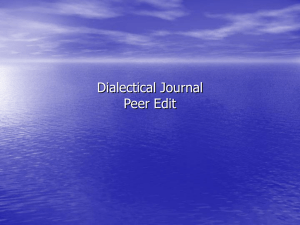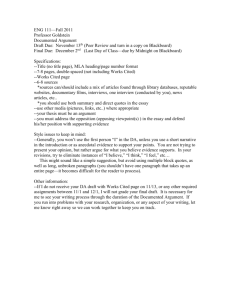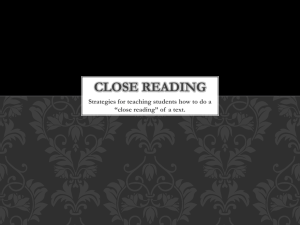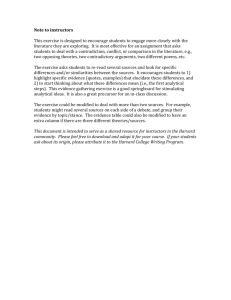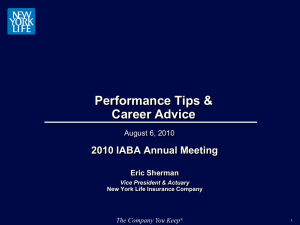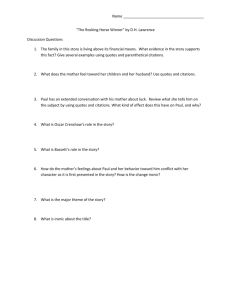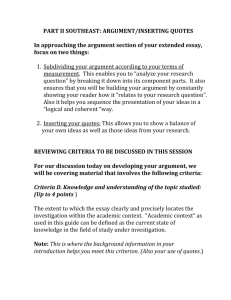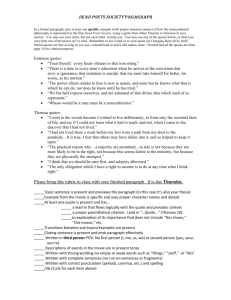1. Use direct quotes when you cannot express what
advertisement
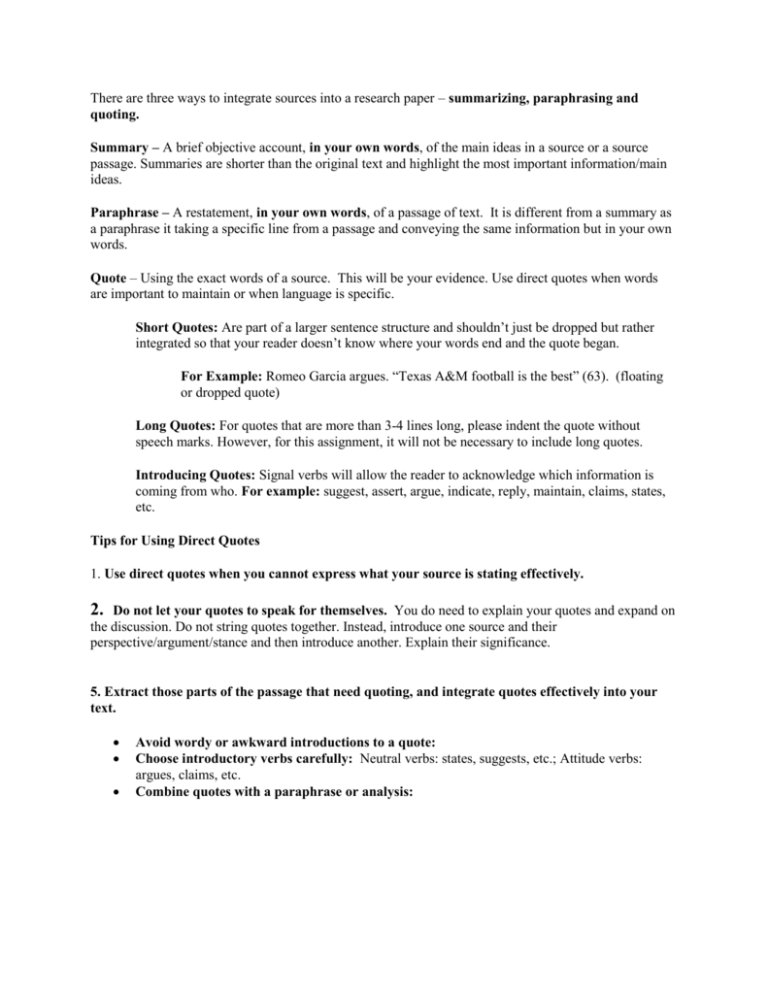
There are three ways to integrate sources into a research paper – summarizing, paraphrasing and quoting. Summary – A brief objective account, in your own words, of the main ideas in a source or a source passage. Summaries are shorter than the original text and highlight the most important information/main ideas. Paraphrase – A restatement, in your own words, of a passage of text. It is different from a summary as a paraphrase it taking a specific line from a passage and conveying the same information but in your own words. Quote – Using the exact words of a source. This will be your evidence. Use direct quotes when words are important to maintain or when language is specific. Short Quotes: Are part of a larger sentence structure and shouldn’t just be dropped but rather integrated so that your reader doesn’t know where your words end and the quote began. For Example: Romeo Garcia argues. “Texas A&M football is the best” (63). (floating or dropped quote) Long Quotes: For quotes that are more than 3-4 lines long, please indent the quote without speech marks. However, for this assignment, it will not be necessary to include long quotes. Introducing Quotes: Signal verbs will allow the reader to acknowledge which information is coming from who. For example: suggest, assert, argue, indicate, reply, maintain, claims, states, etc. Tips for Using Direct Quotes 1. Use direct quotes when you cannot express what your source is stating effectively. 2. Do not let your quotes to speak for themselves. You do need to explain your quotes and expand on the discussion. Do not string quotes together. Instead, introduce one source and their perspective/argument/stance and then introduce another. Explain their significance. 5. Extract those parts of the passage that need quoting, and integrate quotes effectively into your text. Avoid wordy or awkward introductions to a quote: Choose introductory verbs carefully: Neutral verbs: states, suggests, etc.; Attitude verbs: argues, claims, etc. Combine quotes with a paraphrase or analysis: Things to Remember Exigence: The Matter and Motivation of the Discourse What is the discourse about? Why is the discourse needed? What should it accomplish? Rhetor(s): Those People, Real or Imagined, Responsible for the Discourse and Its Authorial Voice Situations can involve multiple rhetors. Audience can influence the rhetor - think about when you sit down to write for different audiences. Audience: Those People, Real or Imagined, with Whom Rhetors Negotiate through Discourse to Achieve the Rhetorical Objectives Many levels, many identities, Audience is dynamic Primary audience / Secondary audience Constraints (+) (-): Factors in the Situation's Context that May Affect the Achievement of the Rhetorical Objectives CONTEXT Working either for or against the rhetor's objectives "all factors in the situation, aside from the rhetor and the audience, that may lead the audience to be either more or less sympathetic to the discourse, and that may therefore influence the rhetor's response to the situation" (Grant-Davie, p. 112). Direct Quotes: Introduce Source the first time around: Frederick Williams (1987) wrote, Technology and Communication Behavior, and argued that technology and communication influence and motivate individual behavior amongst society members (summary). Second time around: Beginning with the first word of the sentence: According to (signal phrase) Williams (1987), “The nature of work is changing as many types of employment involve more information work” (p. 38). Beginning with the second and on word of the sentence: According to (signal phrase) Williams (1987), “…the nature of work is changing as many types of employment involve more information work” (p. 38). Direct Quotes: No Signal Phrase No authors name: Modern society is ever evolving due to advancements in technology that have effectively improved the way we communicate, and, “The nature of work is changing as many types of employment involve more information work” (Williams, 1987, p. 38). Paraphrases: Your Own Words Modern society is ever evolving due to advancements in technology and has effectively improve the way we communicate and exchange information, and has also influence the work environment today (Williams, 1987). Introducing formally (first time): One member of the NRA, Robert Freeman (2006) wrote, “Was the Atomic Bombing of Japan Necessary,” and argues (signal verb) as a whole that the bombing was necessary to maintain the dominant image of the U.S. (summary of the text) Direct Quote: According to (signal phrase) Freeman (2006), he argues, “…atombic bombs are necessary to ensure safety of the U.S.” (p. 38)/ (para. 4). Indirect Quote: To ensure the safety of the U.S. atomic bombs uphold dominance because, “…it scares other nations and threatens their own safety” (Freeman, 2006, p. 38). Paraphrases: To ensure the safety of the U.S. atomic bombs uphold dominance because it reminds other nations and countries who is dominant in the world (Fremman, 2006). Navigating Sources Introduction: Introduce the idea that debates occur on a national, state, local, and even person level (broadly) Introduce how some of these debates take place on a sustainability level of either being political, social, and/or economic. Define sustainability briefly and what it means to have debates Provide some examples (briefly)—you will introduce your topics (on the four levels) Introduce the idea that “texts” disagree with each other on various topics Introduce how and why “texts” disagree with each other (evidence, ethos, pathos, logos, rhetorical situations and constituents) Do not focus entirely on what they are saying but how they are saying it (statistics/evidence/reason/logic)—use evidence for how they back up statements How persuasive and/or effective are they Thesis/Argument: that texts disagree with each other on debatable arguments, and they incorporate various strategies to effectively convey various messages/arguments Context: sustainability; levels; political, social, and/or economic; personal interests Define sustainability according to you Define sustainability according to two sources Introduce the four levels, topics, and ties to sustainability Why are interested in all these topics National: Tell me your topic FYI: 4 paragraphs per level; 2 sources per level; 2 sources are making 2 arguments 1st paragraph argument (Source #1—same source) “For” Topic Sentence: main idea, level, sustainability level, and why its significant Establish the sources credibility/non-credibility 2nd paragraph argument (Source #1—same) “For” Topic sentence: introducing the second main idea/argument 3rd paragraph argument (Source #2—same source) “against” Topic sentence: main idea, level, sustainability level, and why its significant 4th paragraph argument (Source #2—same source) “against” Topic sentence: introducing the second main idea/argument State: Tell me your topic Local: Tell me your topic Personal: Tell me your topic Reflection: Make 4 arguments based on the four levels (you can use the “I” here) Take a side on each level: are you for or against (you do not need any evidence just logic and reasoning) Conclusion: Thesis/argument: That text disagree with each other on debatable arguments, and they incorporate various strategies to effectively convey various messages/arguments Provide your examples as discussed in the four levels Tell me the importance of understanding how sources use different rhetorical strategies Tell me what you learned from this experience; tell me how this has informed your perspective of sustainability in writing and as a student
